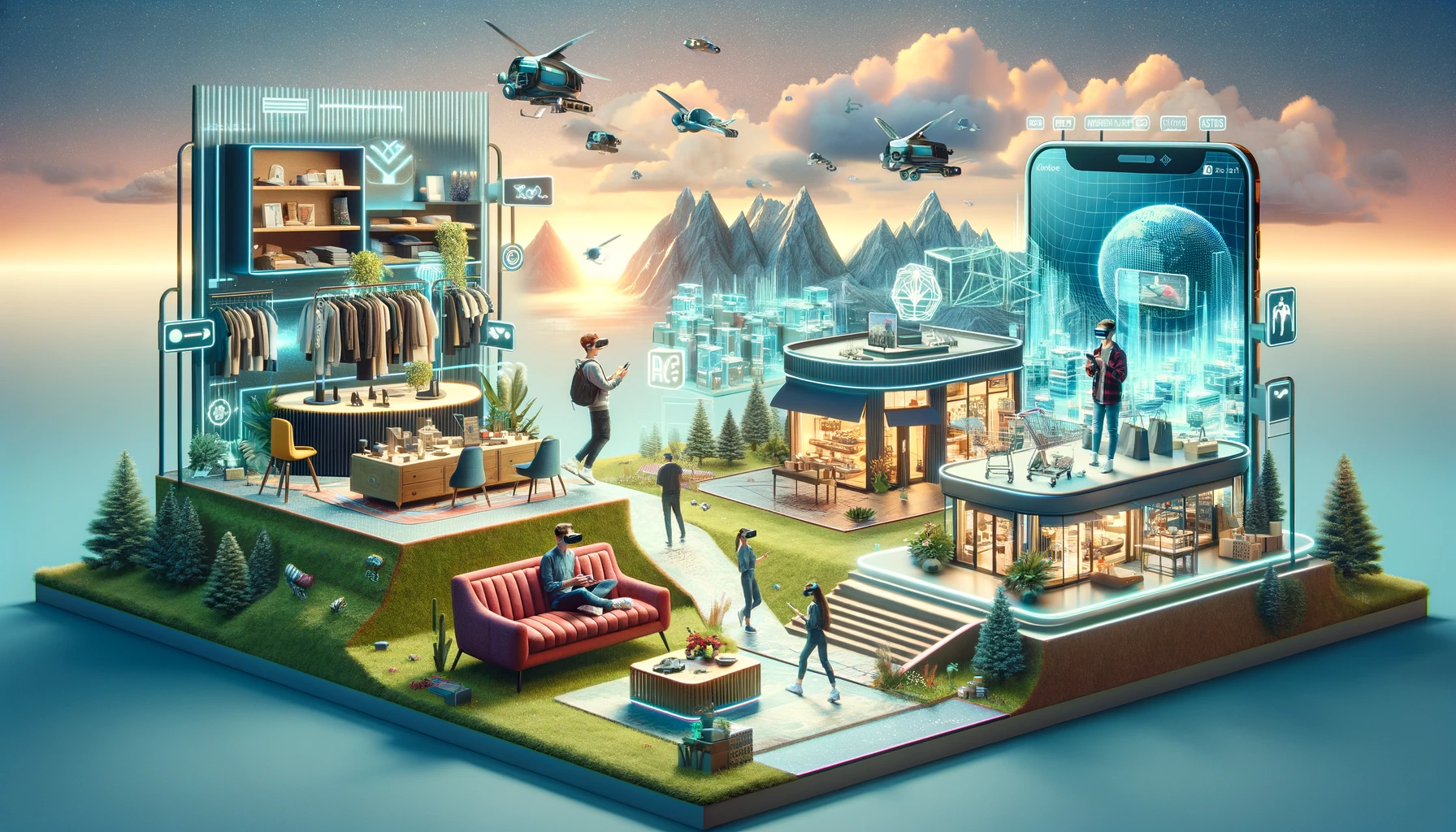6 AR and VR technologies applied in ecommerce
Introduction: the evolution of AR and VR in ecommerce
Ecommerce is constantly evolving, with retailers using technology to enhance the online shopping experience and ultimately drive sales. As technology continues to evolve, new opportunities have emerged to enhance the consumer experience. Among the most profound developments in retail technology are Augmented Reality (AR) and Virtual Reality (VR). AR and VR technologies merge digital and physical worlds, providing an immersive environment where customers can interact with products just as they would in a physical shop.
6 innovative use of AR and VR in ecommerce
AR and VR technologies have seen significant adoption in recent years, offering unprecedented levels of interaction, customisation and personalisation. These digitised experiences are changing the face of ecommerce and enable innovative solutions that can meet and even exceed customer expectations. Whether it is visualising a product in their home using AR or exploring a shop in a virtual environment using VR, these technologies are unlocking a new way for ecommerce companies to engage with their customers.
Just as traditional brick-and-mortar retail evolved into online shopping, ecommerce is poised for a similar leap – a leap made possible by the adoption of AR and VR technologies. As we continue to delve into the transformative potential of these technologies, it is becoming increasingly clear that the future of ecommerce will be anything but one-dimensional.
Enhance product visualization with AR technology
One of the biggest challenges with online shopping has always been the inability to visualize the appearance, size or fit of a product in real life. AR technology is changing that, allowing consumers to literally see what a product would look like in their own space before making a purchase. This is particularly useful for furniture or decor stores who can offer customers an AR tool that allows them to place 3D models of items in their home using a smartphone or tablet.
IKEA for example, has revolutionized the ecommerce experience with its AR app IKEA Place, which allows customers to visualize how their furniture would fit and look in their home. This not only increases customers' confidence in their purchasing decisions, but also reduces the likelihood of returns due to dissatisfaction with size or fit.
Fashion, cosmetics and eyewear brands have also embraced AR technology for product visualization. Online shoppers can upload a selfie and virtually 'try on' items. By allowing consumers to visualize products on themselves or in their homes, these brands help take the guesswork out of online shopping, resulting in higher customer satisfaction and conversion rates.
A revolution in online shopping with VR experiences
With VR, the retail landscape will undergo a huge shift. Virtual Reality brings a whole new dimension to the online shopping experience, allowing consumers to virtually walk through a store, pick up items, view them up close and even try them on. This provides a more enriching and immersive shopping experience compared to scrolling through product listings on a traditional ecommerce website.
Take for example the VR Mall from Alibaba. The Chinese ecommerce giant has created a virtual shopping experience where consumers can browse the stores of their favorite brands in a virtual mall. The VR experience extends to product demonstrations, where customers can interact with 3D renderings of products.
The global fashion brand Tommy Hilfiger has also introduced VR into their stores to provide a unique shopping experience. Customers can put on a VR headset and witness a 360-degree view of the brand's fashion shows, experiencing the brand's offerings in an immersive, new way. Such VR experiences not only ensure that retailers can better present their products; they also add an element of entertainment and engagement to the shopping experience.
Personalize the customer experience through AR
While AR technology can visualize products, it goes a step further by also personalizing the shopping experience. It allows customers to recreate the shopping experience at their convenience and in their environment. Through AR, users can adjust the color, texture or size of the products to suit their space or their preferences, giving the shopping experience a personalized feel.
Companies can also use AR technology for personalized marketing campaigns. Geolocation features allow companies to offer location-based offers and discounts to customers. For example, Starbucks uses AR to provide its customers with a personalized experience, allowing them to scan their coffee cups or other objects in the store to unlock AR experiences such as games and branded animations.
AR's potential for personalization also extends to customer support. Customers often need support or assistance when using a product. With AR, companies can offer interactive guides or AR-driven troubleshooting that provide customers with real-time solutions, improving the customer experience after purchase.
Augmented Reality for tasting experiences
Traditionally, one of the main advantages that brick-and-mortar stores could offer over their online counterparts was the ability for customers to try on items before making a purchase. However, AR is changing this with virtual trial experiences. This innovative use of AR not only improves the online shopping experience, but also significantly reduces the risk of product returns.
Sephora, a leading cosmetics retailer, has pioneered this aspect of AR by developing the 'Virtual Artist' app using ModiFace's AR technology. The app allows users to try out thousands of shades of lip colors, eye shadows and false eyelashes on their faces, virtually.
Similarly, eyewear brands such as Ray-Ban and Warby Parker offer online customers the ability to virtually try on glasses using AR technology. By giving customers the ability to see how a particular frame will fit their face shape and size before ordering, these brands significantly increase customer assurance and satisfaction.
Virtual Reality for immersive product demonstrations
Virtual Reality has proven invaluable to ecommerce by providing immersive product demonstrations. VR allows customers to experience a product in action, something previously only possible in physical stores. For complex or high-priced items, this can significantly increase customers' ability to evaluate products, increasing their confidence to complete the purchase.
For example, car companies such as Audi and Volvo use VR to offer customers a virtual test drive experience with their car. Users can experience the ride and feel of the car and even view various interior and exterior features.
In the same way, technology company offers Shopify a VR app that allows customers to customize and view computer hardware in detail, examine every component and even see it in action. Such immersive product demonstrations significantly enhance the online shopping experience, making it more like shopping in a physical store.
AR and VR technologies for interactive product customization
AR and VR technologies also open new horizons for interactive product customization. Customers can use AR to visualize their unique product configurations in their space, customizing the color, size or specifications to suit their needs. This type of interactive customization serves to build a stronger emotional bond between customers and products because they can essentially design their product, increasing the likelihood of purchase.
For example, Converse's Sampler app uses AR technology, allowing customers to virtually try on any color and style of Converse shoes from the comfort of their home. Similarly, Nike's recently launched Nike Fit app using AR to scan users' feet and recommend the perfect shoe size, offering a high level of customization and personalization.
On the other hand, VR allows companies to create virtual showrooms where customers can browse options and customize products in a rich, immersive environment. For example, car manufacturers such as BMW and Audi use VR to let customers design the interior and exterior of their cars in a highly detailed and interactive way.
The future of ecommerce: integration of AR and VR technologies
The integration of AR and VR technologies into ecommerce offers an exciting new dimension to online shopping. By combining the freedom and flexibility of online shopping with the tangible experience of physical retail, these technologies will revolutionize the way we shop online. As more companies realize the potential of AR and VR, we can expect these technologies to become a mainstay in ecommerce.
Although the adoption of AR and VR in the ecommerce is still in its infancy, the trends are promising – and necessary. Today's consumers want experiences that are not only more personal, but also more immersive. By going a step further to meet this need, AR and VR technologies are paving the way for the future of ecommerce. A future where online shopping is just as rich, interactive and satisfying as – if not more than – shopping in a physical store.


